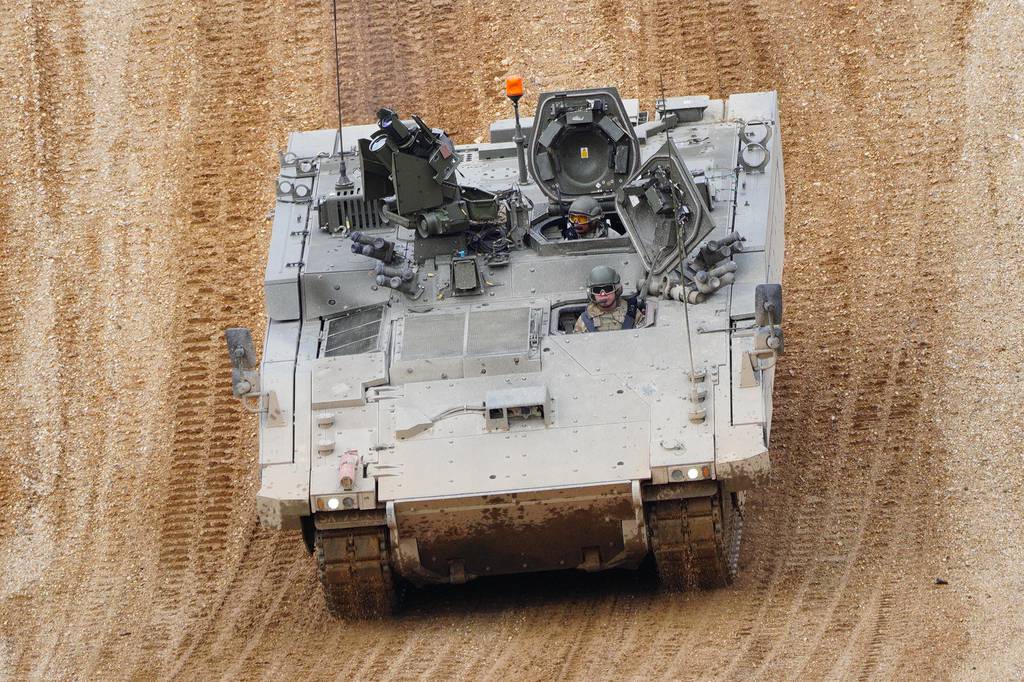
LONDON — The British Defence Ministry has suffered from “systemic, cultural and institutional problems” during its efforts to acquire the Ajax armored reconnaissance vehicle, according to the country’s top weapons buyer.
The comments by James Cartlidge came a few hours after the ministry announced the Household Cavalry Regiment had become the first Army formation to begin field training on the Ajax. His statement to Parliament also follows the June 15 release of a report on lessons learned from the vehicle acquisition program.
The independently run report, led by barrister Clive Sheldon, was ordered by Defence Secretary Ben Wallace last year after the Ajax program suffered repeated delays due to technical issues — mainly related to unsafe levels of noise and vibration, which harmed Army soldiers testing the vehicle.
The delays have until recently threatened the future of the vehicle and its five variants being built in a £5.5 billion (U.S. $7 billion) firm-price deal awarded to General Dynamics Land Systems-UK in 2014 for the production of 589 platforms.
The Ajax was meant to enter service in 2020, but that target date is now 2025, with the declaration of full operational capability expected between October 2028 and September 2029.
The armored cavalry program is a core component of the Army’s transformational effort, dubbed Future Soldier, under which the Ajax variants will primarily be used in reconnaissance and deep-strike roles.
In his statement to Parliament, Cartlidge listed some of the program’s shortcomings cited by Sheldon and his team. These included “fragmented relationships and the conflicting priorities of the senior responsible owner [the head program official] role. It also points to a reticence to raise, and occasionally by seniors to listen to, genuine problems, in a timely evidenced manner,” Cartlidge noted.
The procurement minister, who took on the role in April, said the shortcomings had made “difficult reading“ for the Defence Ministry.
Of Sheldon’s 24 formal recommendations, the government accepted 15, and the other nine in principle, Cartlidge said.
The report noted its recommendations were not meant to achieve a wholesale reconfiguration for the delivery of major programs. “None is a silver bullet. Rather, they represent relatively small improvements, which cumulatively should help the MoD avoid similar problems in future,” the report read.
Sheldon’s report also pointed to friction between the MoD’s Defence Equipment and Support procurement arm and the Defence Science and Technology Laboratory, which provides technical advice.
Furthermore, the report noted, the relationship between Defence Equipment and Support and the prime contractor General Dynamics Land Systems-UK was “not an easy one” and involved “disputes between the parties over many issues.”
Among his recommendations, Sheldon also said top officials running major programs should remain in their posts for a minimum period of five years.
The particular focus of the review covered how the MoD shares and elevates issues across the department and front-line commands, looking at systemic and process-related issues as well as individual action and inaction.
Sheldon said the limited nature of the terms of reference meant he was not asked to look at issues such as whether the right kind of vehicles were procured, the nature and cause of technical problems, and whether the MoD or its contractor should receive the blame for delays and technical problems.
The program was in such mire by the time Sheldon started his review that some were discussing the possibility of misconduct. But Sheldon said he hadn’t attributed blame to individuals because the review had not seen any evidence of misconduct.
“At its highest, I consider that a number of errors of judgment were made at various points, and that ‘optimism bias’ infected some of the thinking of senior individuals working on the program. The failures I identified were systemic and institutional,” he said.
Cartlidge pointed out that “crucially” the review did not find that either “Ministers or Parliament were misled” by program officials.
Meanwhile, Household Calvary Regiment units from the deep reconnaissance strike brigade started field training earlier this week with 44 vehicles, collectively known as Capability Drop 1. Ajax, along with four of the five variants, are involved in the field training.
Reliability growth trials are ongoing to stress the vehicle through a series of battlefield missions. More than 6,600 kilometers (4,101 miles) have been driven on the vehicles, with trials continuing over the coming months.
As of this week, General Dynamics has built 143 of the vehicles at sites in Spain and Wales.
Andrew Chuter is the United Kingdom correspondent for Defense News.
- SEO Powered Content & PR Distribution. Get Amplified Today.
- EVM Finance. Unified Interface for Decentralized Finance. Access Here.
- Quantum Media Group. IR/PR Amplified. Access Here.
- PlatoAiStream. Web3 Data Intelligence. Knowledge Amplified. Access Here.
- Source: https://www.defensenews.com/land/2023/06/15/britains-ajax-program-involved-systemic-and-institutional-failures/
- :has
- :is
- :not
- 1
- 15%
- 2014
- 2020
- 2025
- 2028
- 24
- 70
- a
- accepted
- According
- Achieve
- acquire
- acquisition
- across
- Action
- advice
- After
- along
- also
- an
- and
- announced
- any
- April
- ARE
- ARM
- Army
- AS
- At
- avoid
- awarded
- Battlefield
- BE
- because
- become
- been
- begin
- being
- ben
- between
- Billion
- British
- built
- but
- BUYER..
- by
- came
- Cause
- cited
- collectively
- coming
- comments
- component
- Conflicting
- Consider
- continuing
- Contractor
- Core
- country’s
- covered
- cultural
- Date
- deal
- deep
- defence
- Defense
- delays
- delivery
- Department
- DID
- discussing
- driven
- Drop
- dubbed
- due
- during
- dynamics
- Earlier
- easy
- effort
- efforts
- either
- Enter
- equipment
- Errors
- evidence
- evidenced
- expected
- few
- field
- Find
- First
- five
- Focus
- follows
- For
- formal
- formation
- four
- friction
- from
- front-line
- full
- future
- General
- genuine
- Government
- Growth
- had
- Have
- he
- head
- help
- highest
- his
- HOURS
- household
- How
- HTTPS
- i
- identified
- images
- improvements
- in
- inaction
- included
- independently
- individual
- individuals
- Institutional
- involved
- issues
- IT
- ITS
- jpg
- june
- Kind
- Kingdom
- known
- laboratory
- Land
- Last
- Last Year
- learned
- Led
- Lessons
- Lessons Learned
- levels
- Limited
- Listed
- Look
- looking
- made
- mainly
- major
- manner
- many
- meant
- minimum
- ministry
- missions
- months
- more
- Nature
- news
- noted
- now
- number
- october
- of
- official
- officials
- on
- ongoing
- operational
- or
- Other
- out
- over
- owner
- parliament
- particular
- parties
- period
- Platforms
- plato
- Plato Data Intelligence
- PlatoData
- points
- possibility
- Posts
- primarily
- Prime
- principle
- problems
- Production
- Program
- Programs
- provides
- raise
- rather
- Read
- receive
- recently
- recommendations
- related
- relationship
- Relationships
- relatively
- release
- remain
- repeated
- report
- represent
- responsible
- review
- right
- Role
- roles
- Run
- running
- s
- Said
- Science
- Science and Technology
- secretary
- seen
- senior
- seniors
- September
- Series
- service
- Shares
- shortcomings
- should
- Silver
- similar
- Sites
- small
- some
- Spain
- started
- Statement
- stress
- strike
- such
- support
- systemic
- Target
- team
- Technical
- Technology
- terms
- Testing
- than
- that
- The
- The Future
- the United Kingdom
- their
- These
- they
- Thinking
- this
- this week
- Through
- time
- to
- took
- top
- Training
- transformational
- trials
- u.s.
- under
- United
- United Kingdom
- units
- until
- used
- various
- vehicle
- Vehicles
- was
- Weapons
- week
- WELL
- were
- whether
- which
- WHO
- wholesale
- will
- with
- working
- year
- years
- zephyrnet












